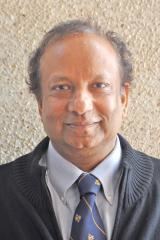Nationality United States | Name Narayanan Komerath | |
 | ||
Occupation Professor of aerospace engineering Known for Asteroid belt structures | ||
The conference chair Dr. Narayanan Komerath, professor of aerospace engineering, at WAVES Conference
Narayanan Menon Komerath is an Indian-born professor of Aerospace Engineering at the Georgia Institute of Technology in the United States. He has written numerous articles and books. He is known for his views on ways to build structures in space from asteroid debris, which could be used for a space-based economy, and for his research into microwave power transmission in space.
Contents
- The conference chair Dr Narayanan Komerath professor of aerospace engineering at WAVES Conference
- Media Byte Interview with Dr Narayanan Komerath at WAVES Dallas Texas 2018
- Career
- Scientific concepts
- Political views
- References
Komerath continues to take an active interest in Indian affairs. He has defended the US-based India Development and Relief Fund, a charity, from accusations that its funds were being used to foster communal violence in India. He has proposed a break-up of Pakistan to remove its ability to export global terror.
Media Byte / Interview with Dr. Narayanan Komerath at WAVES Dallas, Texas - 2018.
Career
Narayanan Menon Komerath was born in Peringavu, Thrissur, India. He studied at the Indian Institute of Technology Madras, obtaining a BTech in Aeronautical Engineering in 1978. He then went to the Georgia Institute of Technology where he obtained a PhD in Aerospace Engineering (Turbulent Combustion) in 1982. Positions since then have included Fellow of the NASA Institute for Advanced Concepts, Sam Nunn Senior Security Fellow in the School of International Affairs (2004–2006) and Hesburgh Teaching Fellow at the Georgia Institute of Technology (2005). From 2008 to 2009 he was Chair of the Aerospace Division of the American Society for Engineering Education. For 2009/2010 he was Secretary/Treasurer of this division. He is Chairman of Scv Inc. in Alpharetta, Georgia, a manufacturer of analytical instruments founded in 1994.
Scientific concepts
In May 2003 Popular Mechanics reported that Komerath had found a way to crush the rocks in the asteroid belts using electromagnetic waves and assemble them into radiation shields and structures where humans could live, among other purposes. The idea came to Komerath by analogy with the technique of "acoustic shaping", where sound waves can accurately position small objects such as beads into larger solid objects within a weightless environment. In space, radio waves would take the place of sound waves. Although huge amounts of energy would be needed, solar power could be used and the approach would avoid the requirement to transport material from Earth. Komerath said "You don't go to investors and say 'I want to build a giant spinning cyclinder in space that would house 10,000 people'. You go and say 'I want to build a space-based economy'. It's a business model that will work only if there are a lot of people who will go broke at the same time if it fails".
Since 2006 Komerath has been considering the problem of a global space power grid. Researchers at Georgia Tech working under the direction of Professor Narayanan Komerath are exploring microwave power beaming in space for military and commercial applications. It is thought that frequencies of around 220 GHz can achieve greater effective distances than the lower frequencies commonly used today. As a rational first step to building a space-based grid Komerath proposes a demonstration project to build a space-based power exchange connecting the United States to India.
Political views
Komerath has been actively and publicly interested in events in the Indian subcontinent since May 1999. With the help of the India Development and Relief Fund (IDRF) he launched the Martyrs for National Integration Fund, which helps the families of people hurt in the war against terrorism. In 2002 leftist activists groups Sabrang Communications and South Asia Citizens Web published The Foreign Exchange of Hate: IDRF and the American Funding of Hindutva, which investigated how funding raised by the IDRF in the USA was being distributed in India. Komerath was one of the authors of a counter-report that denied the implied accusation that tribal activists, who had played a major role in the 2002 Gujarat violence, were linked to US funding sources.
Komerath praised the efforts of grassroots volunteers funded by the IDRF after the December 2004 tsunami. He reported claims that Sri Lankan army personnel had hijacked aid trucks that were trying to assist Tamils. He said US-based Pakistanis were attempting to hinder aid by warning that donations could be misused. Komerath welcomed the July 2005 US–India Civil Nuclear Agreement, but said the refusal of the USA to support India's claim to a permanent seat on the United Nations Security Council was a victory for Pakistan and China. In 2008 Komerath published an opinion paper that called for a break-up of Pakistan into five independent states that would be distracted by protecting themselves. They should be destroyed if they veered towards religious fanaticism or terrorism.
